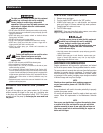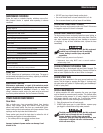
15
MAINTENANCE SCHEDULE
Follow the hourly or calendar intervals, whichever occurs first.
More frequent service is required when operating in adverse
conditions.
First 5 Hours
Change engine oil
Every 8 Hours or Daily
Check/clean water inlet screen*
Check high pressure hose
Check detergent siphoning hose/filter
Check spray gun and assembly for leaks
Clean debris
Check engine oil level
Every 20 Hours or Every Season
Change engine oil**
Every 50 Hours or Every Season
Check/clean air cleaner filter**
Inspect muffler and spark arrester*
Every 100 Hours or Every Season
Service spark plug
* Clean if clogged. Replace if perforated or torn.
** Service more often under dirty or dusty conditions.
PUMP OIL
DO NOT attempt any oil maintenance on this pump. The pump is
pre-lubricated and sealed from the factory, requiring no additional
maintenance for the life of the pump.
EMISSIONS CONTROL
Maintenance, replacement, or repair of the emissions control
devices and systems may be performed by any non-road engine
repair establishment or individual. However, to obtain ”no
charge” emissions control service, the work must be performed
by a factory authorized dealer. See the Emissions Warranty.
POWER WASHER MAINTENANCE
Clean Debris
Daily or before use, clean accumulated debris from cleaning
system. Keep linkage, spring and controls clean. Keep area
around and behind muffler free from any combustible debris.
Inspect cooling air slots and openings on the power washer. These
openings must be kept clean and unobstructed.
Power washer parts should be kept clean to reduce the risk of
overheating and ignition of accumulated debris.
• Use a damp cloth to wipe exterior surfaces clean.
NOTE:
Improper treatment of power washer can damage it and
shorten its life.
• DO NOT insert any objects through cooling slots.
• Use a soft bristle brush to loosen caked on dirt, oil, etc.
• Use a vacuum cleaner to pick up loose dirt and debris.
CHECK AND CLEAN INLET SCREEN
Examine the screen on the pump’s water inlet. Clean it if the screen
is clogged or replace it if screen is damaged.
CHECK HIGH PRESSURE HOSES
The high pressure hoses can develop leaks from wear, kinking, or
abuse. Inspect the hoses each time before using them. Check for
cuts, leaks, abrasions or bulging of cover, damage or movement
of couplings. If any of these conditions exist, replace the hose
immediately.
The high pressure stream of water that this equipment
produces can cut through skin and its underlying
tissues, leading to serious injury and possible
amputation.
• NEVER repair high pressure hose. Replace it.
• Replacement hose rating MUST meet or exceed maximum
pressure rating of unit.
CHECK DETERGENT SIPHONING TUBE
Examine the filter on the detergent tube and clean if clogged. The
tube should fit tightly on the barbed fitting. Examine the tube for
leaks or tears. Replace the filter or tube if either is damaged.
CHECK SPRAY GUN
Examine the hose connection to the spray gun and make sure it is
secure. Test the trigger by pressing the trigger, it “springs back”
into place when you release it. Replace spray gun immediately if
it fails to "spring back".
NOZZLE MAINTENANCE
A pulsing sensation felt while squeezing the spray gun trigger
may be caused by excessive pump pressure. The principal cause
of excessive pump pressure is a nozzle clogged or restricted
with foreign materials, such as dirt, etc. To correct the problem,
immediately clean the nozzle following these instructions:
1. Shut off engine and turn off water supply.
2. ALWAYS point spray gun in a safe direction, squeeze spray
gun trigger to release retained high water pressure.
The high pressure stream of water that this equipment
produces can cut through skin and its underlying
tissues, leading to serious injury and possible
amputation. Spray gun traps high water pressure, even
when engine is stopped and water is disconnected,
which can cause injury.
Maintenance


















